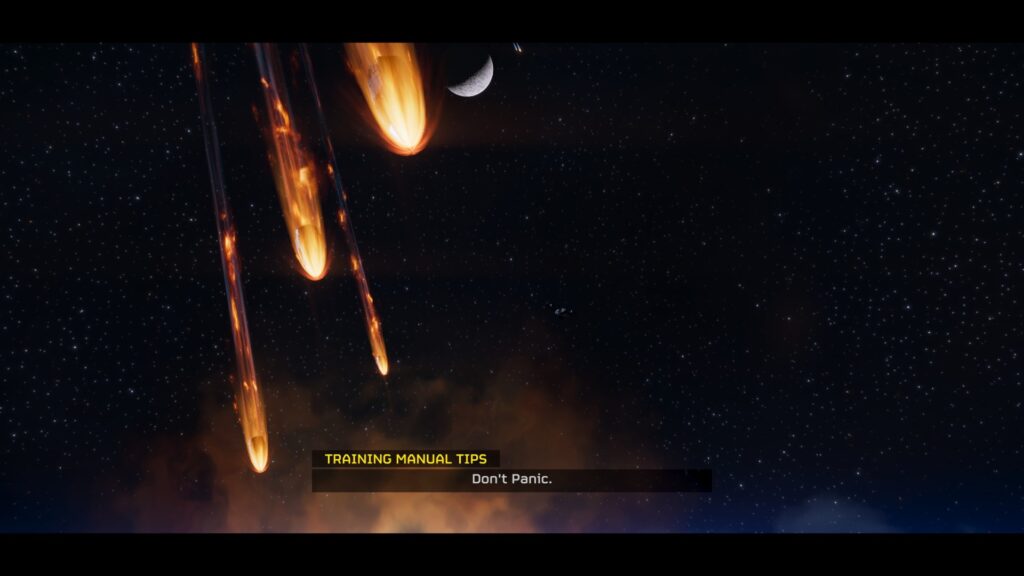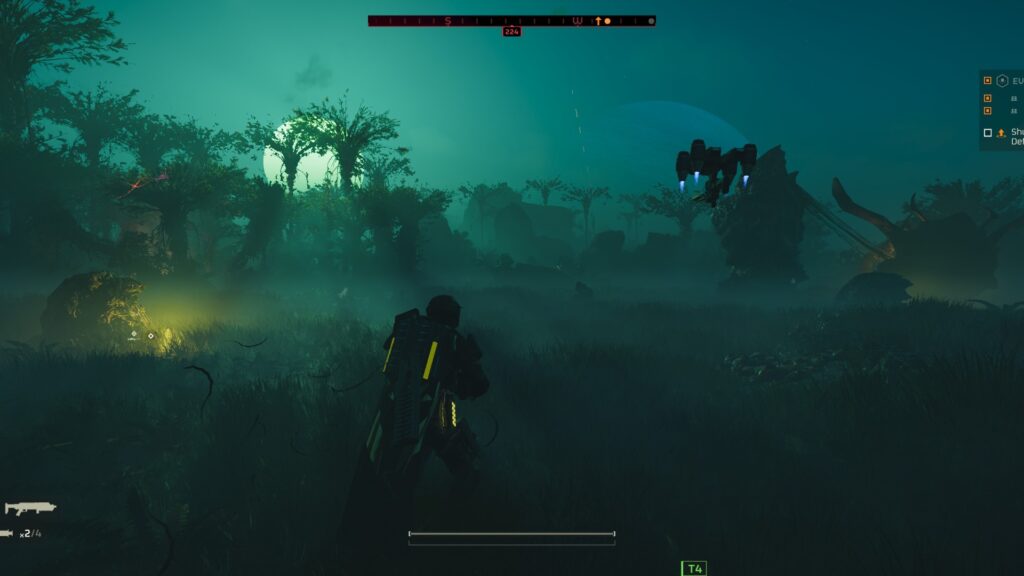As a fan of the original Helldivers, I was beyond excited when the sequel was announced. Helldivers always felt like a one-off game, a cult classic that would be released and eventually lost to time except for the few people who truly loved it. Never in my wildest dreams did I think it would get a bigger-budget sequel, especially at a time when developers and publishers seem to be playing it safe, that just doesn’t happen these days. Lo and behold, Helldivers II is that sequel, a bigger, broader vision, one that also happens to fit in with Sony’s recent push to establish themselves in the live service game, for better or worse depending on how you feel about games as a service (more on that later). Based on the concurrent player numbers, the game is a hit.
The shift from isometric to behind-the-back is drastic and a bit risky for a developer who hasn’t strayed away from that perspective up until now. As exciting as it looked, it would have been easy to assume that they might not be cut out for more traditional third-person shooting or that they might play it a bit safe. Luckily, the team at Arrowhead was up to the task as the shift was executed flawlessly while also embracing the physics humor that occurred in their previous game. Getting blown away by a grenade used to be funny, but watching your character ragdoll through the air 50 feet away now that players aren’t restricted to sharing a screen is hilarious. Watching bugs explode into giblets or seeing Automatons break down and fall to pieces from a shotgun blast is immensely satisfying and the physics system ensures these moments don’t feel like canned animations. Levels are surprisingly vast and gorgeous to look at, ranging from lush jungles to stormy environments with jellyfish floating around. As the pre-mission tips say, you should take at least 2.4 seconds to appreciate your surroundings.
Maps are loaded with resources and side objectives, most of which are not immediately apparent. Despite the timer putting pressure on you to complete your main objective, it is so important you seek these out as they’ll be necessary for upgrades that you’ll need as you progress through the game. Blinking beams of light will guide you to caches filled with samples, credits, or weapons to use on your mission and other points of interest can similarly be chock full of goodies. The upgrades you’ll unlock with these resources might start small, with more ammo when you land with support weapons or a slightly shorter cooldown on stratagems, but once fully upgraded you can get additional uses and more. Once you have them, you’ll wonder how you ever made it without them.

Movement and shooting both feel tight and satisfying and only get better as you grow more experienced. There is a nice fluidity in being able to run in, take a few shots, dive back while firing, quickly get up, and sprint away while reloading your weapon. I don’t want to call it forgiving, because it certainly is not, but it feels friendly. Learning the nuance of the movement is critical but once you know it you quickly learn the ways you can abuse it to make some hero plays. The base over-the-shoulder view when firing is nice and I appreciate that the devs went the extra mile of having two reticles, a traditional center reticle and a reactive one that shows where your shots are actually going, avoiding some of the perspective issues that sometimes come with third-person-shooters. The amount of times I haven’t fired my autocannon into the cover I’m behind rather than the enemy I was trying to target is far less than average thanks to that extra reticle and I hope more developers implement something similar in third-person games.
Weapons feel chunky against the rank and file regardless of what you’re using, but as difficulty increases and the amount of armored units increases alongside that you’ll start to feel the difference between the levels of armor penetration on weapons. A strategic loadout is critical for your success and bringing the wrong gear is a recipe for rapid failure. Support weapons, the “big guns”, are game changers. Whether you’re bringing a machine gun to keep numbers down, an autocannon for general effectiveness, or a railgun for heavy armor-piercing, your decisions before you drop are almost more important than the ones you make on the ground. Equally important in your arsenal are stratagems. These range from defensive turrets to orbital strikes and also encompass your support weapons. Knowing what is effective for your current mission and knowing when and how to use it is critical for success, as is knowing the combo for the stratagem you’re trying to use. Unfamiliar players might find them daunting as they have to execute several directional inputs while under pressure from enemies, but over time you’ll memorize your most used and rattle them off like nothing.
Of course, you’re going to need to learn (probably the hard way) what is effective against the two (for now, it seems pretty clear there’s room for more baddies in the future) factions in the game. The bugs have the smallest of the small and the biggest of the big, offering the most diversity in enemy types and it can be a lot to manage. The small bugs are usually nothing to worry about unless you’re caught without ammo and surrounded, but bugs like the hunters, their bigger cousins, can single-handedly send you to an early grave. Some bugs keep fighting for a few seconds after the killing blow, others, like the charger or bile titan, are heavily armored and can take an obnoxious amount of resources to deal with until you know the right way to handle them. The Automatons are, as a rule, “easier” to deal with as they don’t have as many heavily armored units as the bugs. The issue with them is that, unlike most of the bugs, they shoot back, and they hit hard. The various flavors of devastator can wipe you out in less than a second and the hulking…hulks, have thick armor and heavy arsenals that can wipe an entire squad faster than you can ping them. Especially on the endgame difficulty levels, Helldivers is a hard game that is only overcome through proper teamwork and planning, or sheer dumb luck and persistence.
The vibe of Helldivers II is mixed but fully realized. Much of the humor of the original carries over such as yelling “FREEDOM!” at the top of your lungs when firing sustained bursts or talking about cups of “Liber-tea”. The dystopian Super Democracy of Super Earth reminds you it is always watching and propaganda assaults you at every turn, building the notion that you’re clearly fighting on the right side, unless you’re a traitor…you’re not a traitor, right? At the same time, the game has this immense feeling of badass starting from the moment you enter your Hellpod and the music kicks in. I don’t think it is possible to not feel the energy of every drop as you’re launched from the super destroyer, the music focused, determined, as you plummet to the surface below. I’ve run over 100 successful missions and I’m still excited for every drop. Even when I’m not playing Helldivers someone is bound to belt out the “Dun Du Du Duhhhh” from the drop. Then the frantic final moments when the dropship is coming in, the last 10 seconds of music that hits as you rally the team to get on the damn ship as enemies overwhelm you, sublime. I feel genuine relief when we complete a full extraction on Helldive difficulty and savor the triumphant track that plays me back to my destroyer.

If Helldivers II has any issue it’s that it encourages rigidness in its gameplay, especially in the higher difficulties. There are so many great weapons to choose from, but there is always one that feels like the right choice for the bugs or the Automatons, often to the detriment of other similarly effective weapons. Arrowhead’s desire to push players into more stratagem use ends up working the same way with only a handful deemed useful while the others languish in the armory collecting dust. Why bring the Orbital Smoke when the Orbital laser can wipe an entire Automaton base? Utility is overlooked and sacrificed because it doesn’t make a big enough explosion, the real draw to the game. While I don’t believe more rigidness in the selection of weapons and stratagems would alleviate the problem, there has to be something to make utility more appealing to players, otherwise, everything that doesn’t go boom is simply “useless”.
It is also worth noting that Helldivers II is a live service game. There is a free Warbond where you unlock new gear (basically a battle pass) and a premium version with additional unlocks. Arrowhead has confirmed that Warbonds will never go away and players can unlock their contents at any time with the medals they earn from completing operations. I think it is great that the first pass with the majority of the gear is free, but it doesn’t feel great to have to unlock content that we got for leveling up in the original game by “earning” it from the battle pass. Considering that the overall weapons selection, including both Warbonds, feels a little lacking, especially when three of the guns are variants of the same gun.
The Premium Warbond doesn’t feel particularly premium (three pages compared to ten in the free one) and the medal cost is higher, meaning that not only do you have to pay for it to unlock anything, but you also have to invest the same medals you’re already using to try and unlock your normal guns. You can’t buy medals so I wouldn’t call it pay-to-win or anything like that, though you can outright buy gear from the Superstore, though that is just armor and helmets with similar effects to items found in the Warbonds. You do earn Super Credits, the paid currency, from the free Warbond and can also find it in missions so it is entirely possible to earn the Premium Warbond without paying a penny for it. Despite how I might come off, I don’t find the monetization to be egregious, but it is worth noting.
Helldivers II is exactly the game it wants to be, which is its most endearing quality. Arrowhead could have played it safe and stuck to the original formula and achieved another cult hit on their list of cult hits. Instead, they went for broke, redesigning the game from the ground up while doubling down on the things that made it stand out, the unbashed political humor, the hilarious physics, and the tight mission structure. What emerged is one of the finest sequels to a game you could ask for, but one that feels a little too rigid and unforgiving when it matters most. I’ll be looking forward to all the new content coming down the pipe and I expect that most of the players who hopped on the hype train will stick around for the long haul. What are you waiting for Helldiver? Get out there and spread some Democracy for Super Earth!
Helldivers II: Bigger in scope, substance, and popularity, Helldivers II is a sequel that successfully reinvents the wheel and does more with with much less than it's contemporaries. An absolute hit you'll be talking about, and playing, all year and beyond. – Chris



